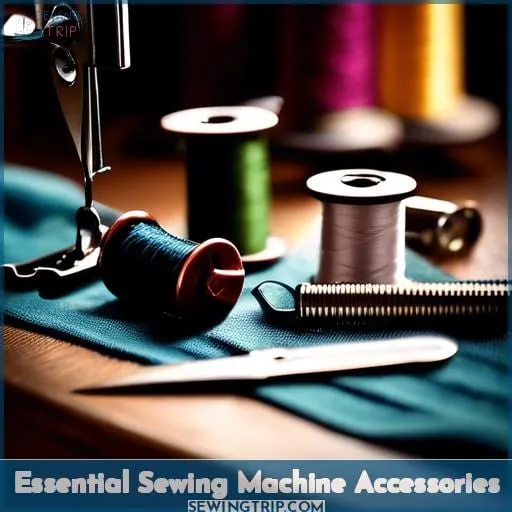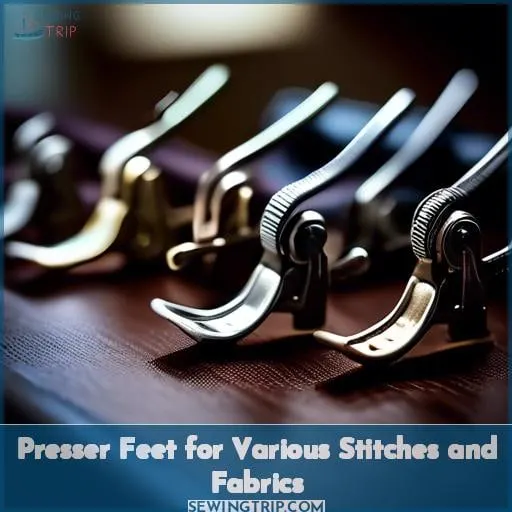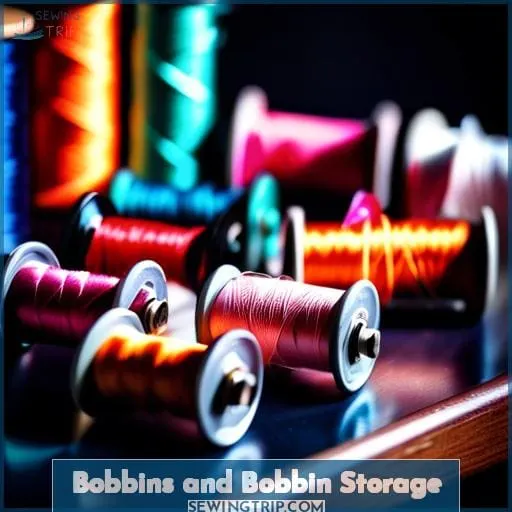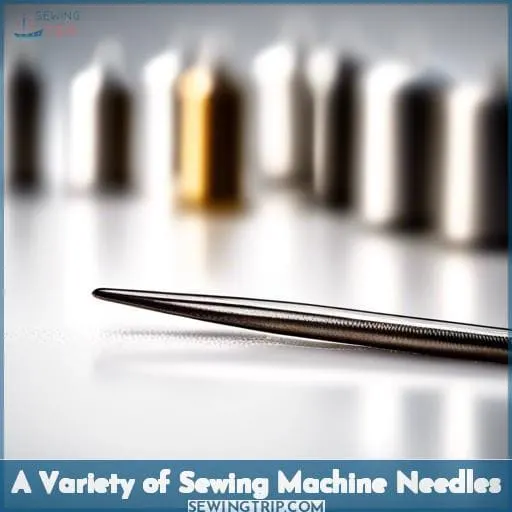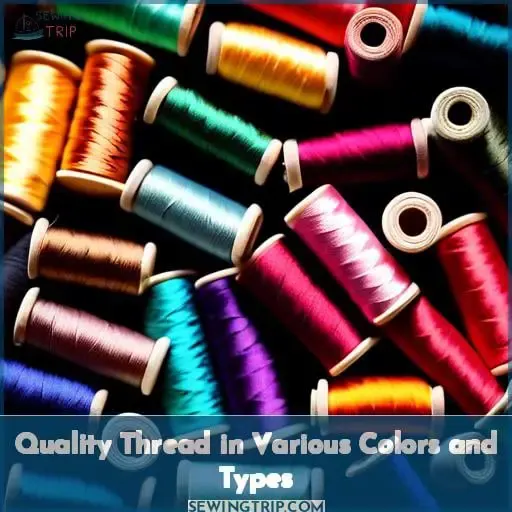This site is supported by our readers. We may earn a commission, at no cost to you, if you purchase through links.
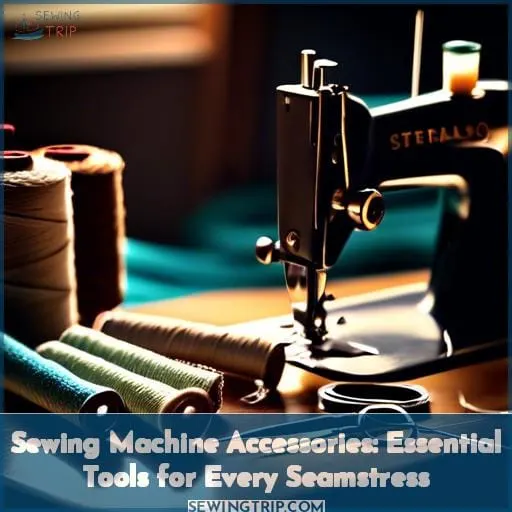
Whether you’re stitching your first seam or crafting couture, these essentials are your allies in every stitch. From presser feet that glide over various fabrics to bobbins that keep your threads in check, these tools are the unsung heroes behind every creation.
Dive into the world of sewing machine accessories and arm yourself with the quality thread, needles, and storage solutions you need to turn your visions into tangible art.
Yes, essential sewing machine accessories include a presser foot, magnetic seam guide, bobbins, sewing machine needles, thread nippers, and maintenance tools like oil and cleaning brushes.
Table Of Contents
Key Takeaways
- Utilize a variety of presser feet for specific tasks, such as a zipper foot for sewing zippers and a walking foot for handling thick fabrics, to enhance the precision and quality of your sewing projects.
- Keep an assortment of bobbins, including Class 15, L style, and M style, and maintain them with proper winding and cleaning to ensure smooth sewing and to accommodate different fabric types and project scales.
- Select sewing machine needles appropriate for the fabric you’re working with, such as size 70/10 for sheer fabrics and size 110/18 for heavy-duty materials, and use a needle storage system to keep them organized.
- Invest in high-quality thread to reduce the likelihood of breakage and fraying, and maintain a variety of colors and types, including specialty threads, to match your fabric and add unique effects to your projects.
Essential Sewing Machine Accessories
As you embark on your sewing journey, think of your sewing machine as a trusty steed, and just like any good ride, it needs the right gear to perform at its best. Imagine trying to sew without your trusty seam ripper—like trying to eat soup with a fork, right? That little lifesaver is there to undo those oops moments faster than you can say reverse sewing.
And let’s not forget about sewing clips, the unsung heroes that keep your fabric in line without leaving a trace, unlike those traitorous pins that sometimes seem to have a taste for fabric.
Now, picture yourself armed with a thimble, the knight’s armor for your fingertip, ready to battle against any needle that dares to challenge you. And a measuring tape—your treasure map—guiding you through the fabric jungles with precision.
Lastly, fabric scissors, the Excalibur of your sewing table, ready to make the cut as smoothly as a hot knife through butter. With these essential tools, you’re not just sewing; you’re crafting a masterpiece with every stitch.
Presser Feet for Various Stitches and Fabrics
When it comes to sewing, having the right presser foot can feel like you’ve got a fairy godmother in your sewing room. Imagine you’re working with a slippery satin or a stubborn denim—without the right foot, it’s like trying to thread a needle with boxing gloves on! But with the right presser foot, it’s smooth sailing.
Here’s a quick rundown of some specialized presser feet that could be game-changers for your projects:
- Zipper Foot: This little gem lets you stitch zippers without breaking a sweat, getting close to the teeth without biting.
- Walking Foot: Like a trusty sidekick, it feeds thick or layered fabrics evenly, preventing the dreaded pucker.
- Buttonhole Foot: It’s like having a GPS for sewing buttonholes—straight to the destination without any detours.
- Blind Hem Foot: For hems that are there but not there—like a magic trick for your trousers.
- Embroidery Foot: Unleash your inner artist with free-motion stitching, turning fabric into a canvas.
Bobbins and Bobbin Storage
Just as the right presser foot can make a stitch glide smoother than butter on a hot skillet, the humble bobbin is the unsung hero of the sewing world. Think of it as the Robin to your Batman, the Watson to your Sherlock. Without it, your sewing machine is just a fancy paperweight.
But not all bobbins are created equal, and knowing your way around them can make a world of difference.
| Bobbin Type | Best For |
|---|---|
| Class 15 | General sewing tasks; versatile and widely used. |
| L Style | Delicate fabrics and detailed work. |
| M Style | Heavy-duty projects; holds more thread for longer runs. |
Bobbin winding is an art in itself. You want that thread on there snug but not too tight, like a perfect handshake. And let’s talk bobbin tension – it’s the Goldilocks of sewing. Too loose, and your stitches will be looser than a goose.
Too tight, and you’ll snap that thread faster than a twig. It’s all about finding that just right tension.
Now, onto bobbin storage containers. They’re the knights in shining armor protecting your bobbins from the chaos of the sewing room. Because let’s face it, a bobbin rolling into oblivion is a tale as old as time. And while we’re at it, don’t forget about bobbin case cleaning.
A clean bobbin case is a happy bobbin case, ensuring your sewing machine purrs like a kitten.
So, there you have it. Bobbins might be small, but they’re mighty. Treat them well, and they’ll ensure your sewing journey is smooth sailing.
A Variety of Sewing Machine Needles
Just as you wouldn’t use a butter knife to slice a tomato, you can’t expect one needle to handle every sewing task. Needle sizes and types are as varied as the fabrics they pierce. For instance, a delicate 70/10 needle glides through sheer fabrics without a snag, while a sturdy 110/18 needle can tackle a tough denim project without breaking a sweat.
Keep your needles organized and at the ready; a needle storage system can prevent those pesky needle in a haystack moments. And if threading needles makes you squint, consider a needle with a larger eye or a built-in threader to save your eyesight—and your sanity.
With the right needle in hand, you’re not just sewing; you’re crafting masterpieces with every stitch.
Quality Thread in Various Colors and Types
As you dive into your next sewing project, remember that the thread you choose is the lifeline of your creation. It’s not just about picking a rainbow of colors to match your vibrant personality; it’s about ensuring your stitches hold true through every wear and wash.
- Thread Quality: Don’t skimp on this! High-quality thread means fewer breakages, less fraying, and a smoother sewing experience. It’s the invisible hero that keeps your seams strong and your fabrics united.
- Thread Selection: It’s a colorful world out there, and your thread selection should reflect that. But beyond colors, consider the types of thread—polyester for strength and durability, cotton for a soft finish, or perhaps a specialty thread for that extra sparkle.
- Thread Storage: Keep your threads organized and protected. A tangle-free zone not only saves time but also preserves the integrity of your thread, ensuring it’s ready for action when you are.
Frequently Asked Questions (FAQs)
How can I prevent my sewing machine from skipping stitches when working with thick fabrics or multiple layers?
To dodge skipped stitches on thick fabrics, switch to a new, hefty needle—think size 90/14 or 100/16—and opt for a longer stitch length.
Slow and steady wins the race; don’t rush it.
What are the best practices for storing my sewing machine when not in use to ensure its longevity?
Keep your sewing machine covered and tucked away in a cool, dry spot, safe from the sun’s kiss and temperature tantrums.
A dust cover’s embrace keeps pesky lint at bay—your machine’s knight in shining armor.
Can I use a universal needle for embroidery projects, or do I need a specific type of needle?
You can’t always use a universal needle for embroidery. It’s like trying to fit a square peg in a round hole.
You’ll need embroidery needles with a larger eye to protect delicate threads.
How do I choose the right presser foot for sewing delicate fabrics like silk or chiffon without causing damage?
For sewing delicate fabrics like silk or chiffon, opt for a walking foot. This prevents fabric stretching and slipping, ensuring smooth seams without damage.
Alternatively, adjust your standard presser foot’s height to lessen pressure.
What are the signs that indicate my sewing machine needs professional servicing or maintenance?
If your sewing machine is making strange noises or skipping stitches, it’s time to see a pro.
Don’t let a stitch in time save nine become a stitch too late!
If the fabric is bunching, it’s another sign that professional attention is needed.
Conclusion
Armed with the right sewing machine accessories, you’re set to tackle any project that comes your way. Remember, the key to seamless stitches and beautiful finishes lies in the tools you use.
Whether you’re a novice or a seasoned seamstress, having a variety of presser feet, an assortment of bobbins, and needles for every fabric type will ensure you’re prepared for any sewing challenge.
Don’t forget to stock up on quality thread in a rainbow of colors to bring your creations to life. With these essentials, you’ll turn your sewing visions into tangible art, making the most of what sewing machine accessories do you need.

